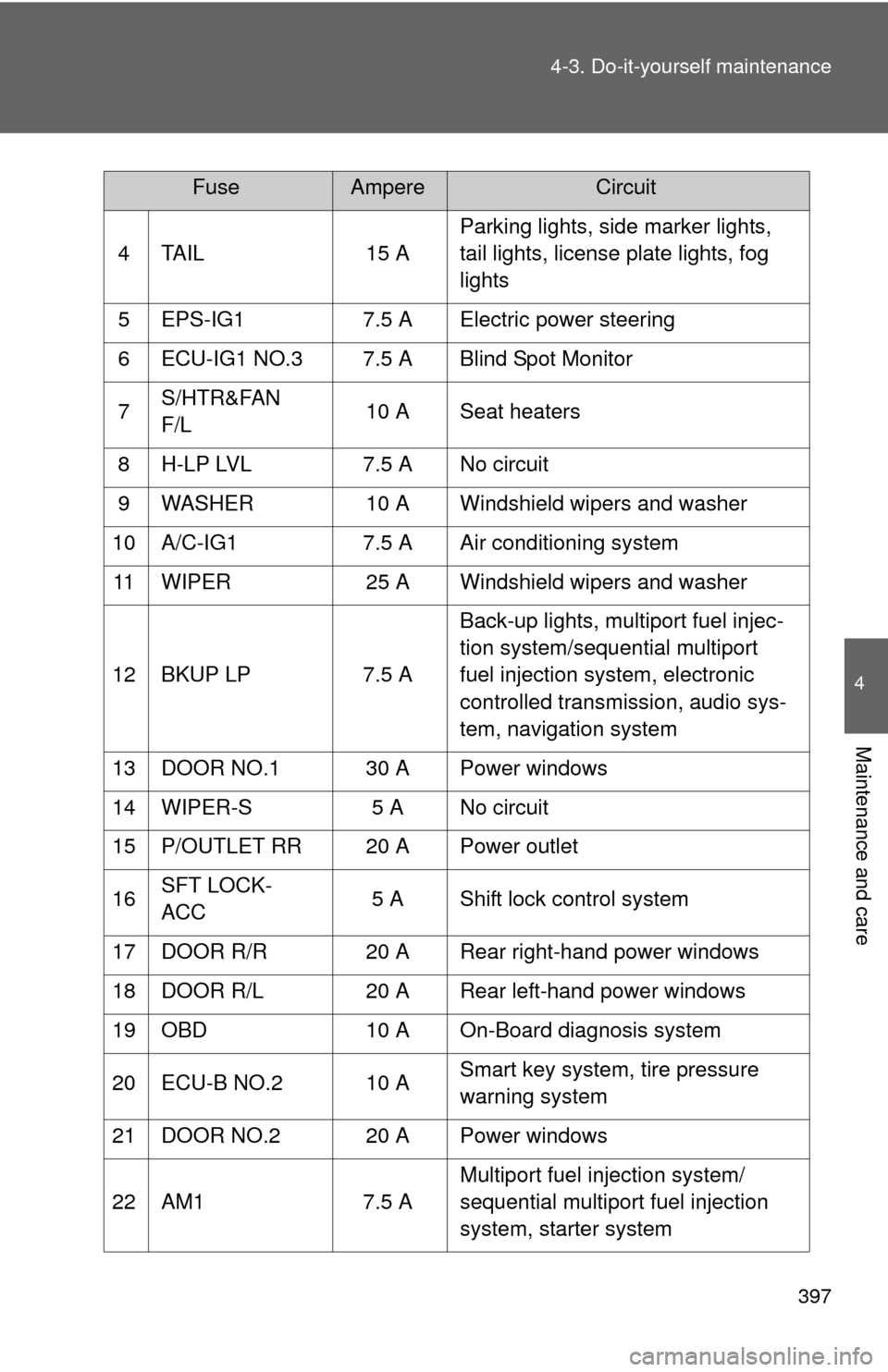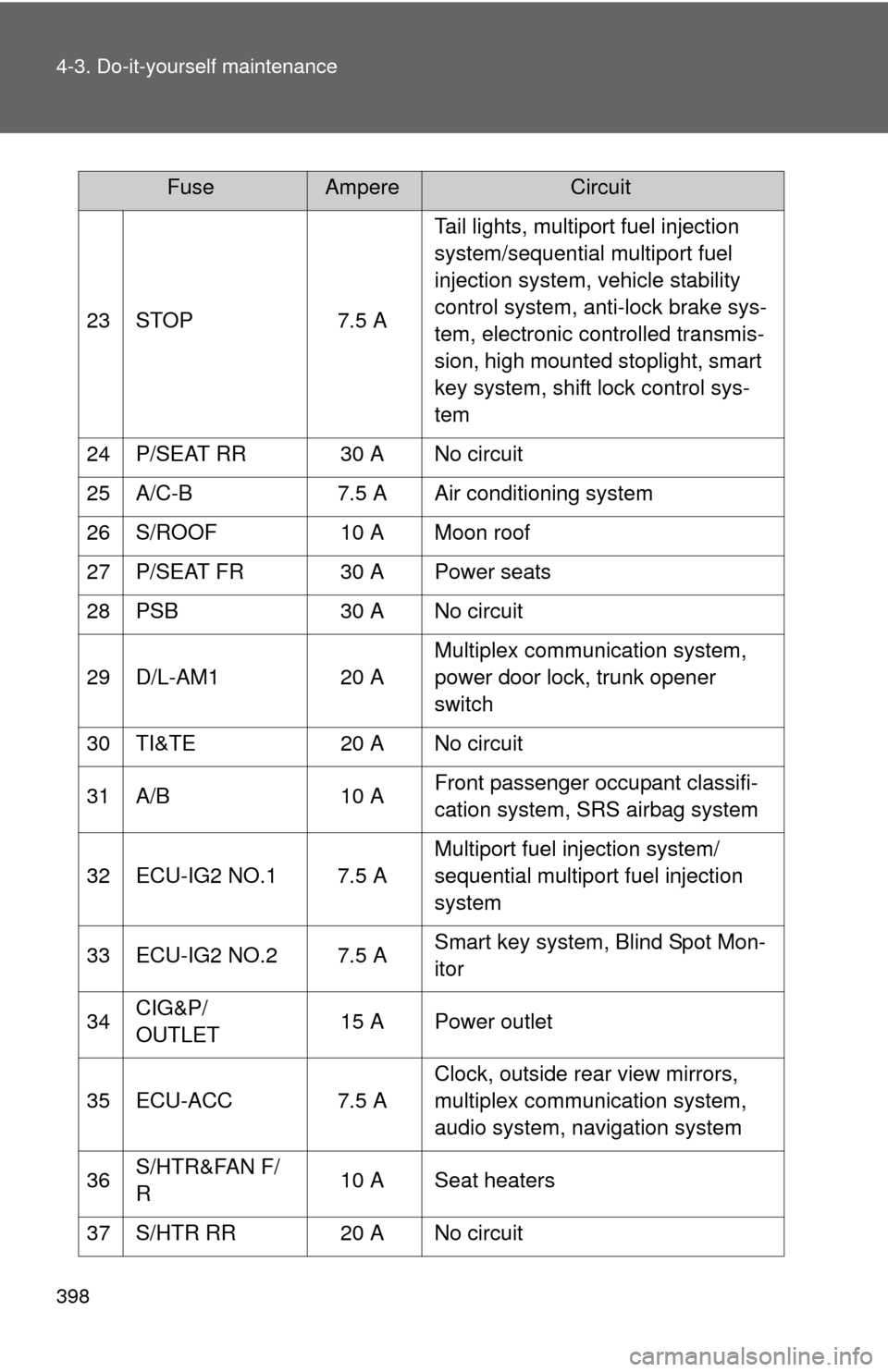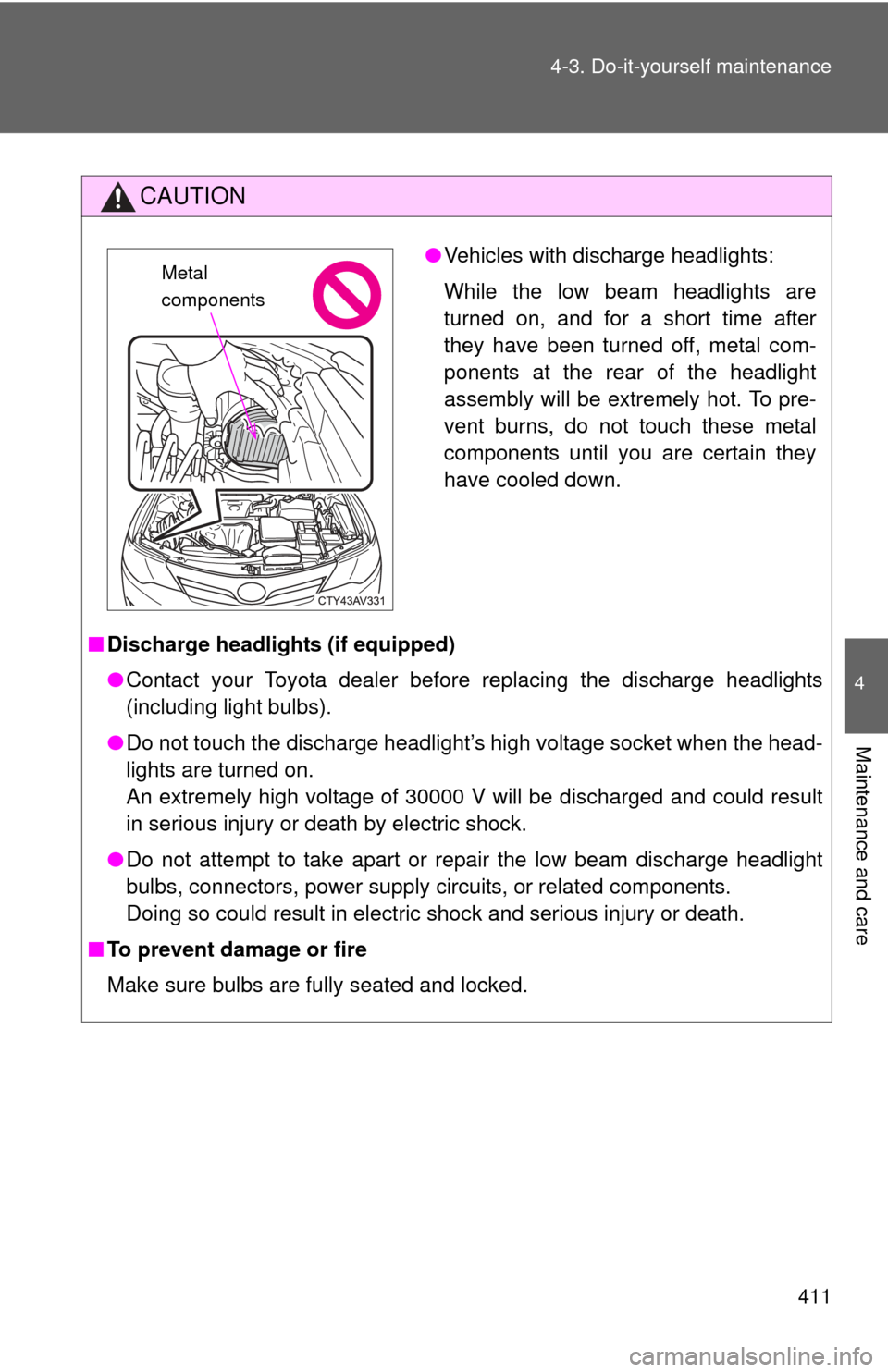Page 397 of 532

397
4-3. Do-it-yourself maintenance
4
Maintenance and care
4 TAIL
15 AParking lights, side marker lights,
tail lights, license plate lights, fog
lights
5 EPS-IG1 7.5 A Electric power steering
6 ECU-IG1 NO.3 7.5 A Blind Spot Monitor
7 S/HTR&FAN
F/L 10 A Seat heaters
8 H-LP LVL 7.5 A No circuit
9 WASHER 10 A Windshield wipers and washer
10 A/C-IG1 7.5 A Air conditioning system
11 WIPER 25 A Windshield wipers and washer
12 BKUP LP 7.5 ABack-up lights, multiport fuel injec-
tion system/sequential multiport
fuel injection system, electronic
controlled transmission, audio sys-
tem, navigation system
13 DOOR NO.1 30 A Power windows
14 WIPER-S 5 A No circuit
15 P/OUTLET RR 20 A Power outlet
16 SFT LOCK-
ACC 5 A Shift lock control system
17 DOOR R/R 20 A Rear right-hand power windows
18 DOOR R/L 20 A Rear left-hand power windows
19 OBD 10 A On-Board diagnosis system
20 ECU-B NO.2 10 A Smart key system, tire pressure
warning system
21 DOOR NO.2 20 A Power windows
22 AM1 7.5 AMultiport fuel injection system/
sequential multiport fuel injection
system, starter system
FuseAmpereCircuit
Page 398 of 532

398 4-3. Do-it-yourself maintenance
23 STOP7.5 ATail lights, multiport fuel injection
system/sequential multiport fuel
injection system, vehicle stability
control system, anti-lock brake sys-
tem, electronic controlled transmis-
sion, high mounted stoplight, smart
key system, shift lock control sys-
tem
24 P/SEAT RR 30 A No circuit
25 A/C-B 7.5 A Air conditioning system
26 S/ROOF 10 A Moon roof
27 P/SEAT FR 30 A Power seats
28 PSB 30 A No circuit
29 D/L-AM1 20 AMultiplex communication system,
power door lock, trunk opener
switch
30 TI&TE 20 A No circuit
31 A/B 10 AFront passenger occupant classifi-
cation system, SRS airbag system
32 ECU-IG2 NO.1 7.5 A Multiport fuel injection system/
sequential multiport fuel injection
system
33 ECU-IG2 NO.2 7.5 A Smart key system, Blind Spot Mon-
itor
34 CIG&P/
OUTLET 15 A Power outlet
35 ECU-ACC 7.5 A Clock, outside rear view mirrors,
multiplex communication system,
audio system, navigation system
36 S/HTR&FAN F/
R 10 A Seat heaters
37 S/HTR RR 20 A No circuit
FuseAmpereCircuit
Page 399 of 532
399
4-3. Do-it-yourself maintenance
4
Maintenance and care
■
After a fuse is replaced
●If the lights do not turn on even after the fuse has been replaced, a bulb
may need replacement. ( P. 401)
● If the replaced fuse blows again, have the vehicle inspected by your
Toyota dealer.
■ If there is an overload in a circuit
The fuses are designed to blow, protecting the wiring harness from damage.
■ When replacing light bulbs
Toyota recommends that you use genuine Toyota products designed for this
vehicle. Because certain bulbs are connected to circuits designed to prevent
overload, non-genuine parts or parts not designed for this vehicle may be
unusable.
Page 402 of 532
402 4-3. Do-it-yourself maintenance
Replacing light bulbs■ Headlight high beam and daytime running light
Turn the bulb base counterclock-
wise.
Unplug the connector while
depressing the lock release.
■Rear bulb locations
Rear turn signal light
Stop/tail light License plate lightsBack-up light
Rear side marker light
STEP1
STEP2
Page 409 of 532
409
4-3. Do-it-yourself maintenance
4
Maintenance and care
■
Lights other than the above
If any of the lights listed below has burnt out, have it replaced by
your Toyota dealer.
● Headlight low beams (discharge bulb)
● High mounted stoplight
■Discharge headlights (if equipped)
If voltage to the discharge bulbs is insufficient, the bulbs may not come on,
or may go out temporarily. The discharge bulbs will come on when normal
power is restored.
■ LED light bulbs
The high mounted stoplight consists of a number of LEDs. If any of the LEDs
burn out, take your vehicle to your Toyota dealer to have the light replaced.
■ Condensation build-up on th e inside of the lens
Contact your Toyota dealer for more information in the following situations.
Temporary condensation build-up on the inside of the headlight lens does
not indicate a malfunction.
● Large drops of water have built up on the inside of the lens.
● Water has built up inside the headlight.
Page 410 of 532
410 4-3. Do-it-yourself maintenance
■Removing and installing the clips
The luggage trim cover and trunk panel cover clip
The fender liner clip
■ When replacing light bulbs
P. 399
CAUTION
■Replacing light bulbs
●Turn off the lights. Do not attempt to replace the bulb immediately after
turning off the lights.
The bulbs become very hot and may cause burns.
● Do not touch the glass portion of the light bulb with bare hands. Hold the
bulb by the plastic or metal portion.
If the bulb is scratched or dropped, it may blow out or crack.
● Fully install light bulbs and any parts used to secure them. Failure to do so
may result in heat damage, fire, or water entering the headlight unit. This
may damage the headlights or cause condensation to build up on the lens.
Removing
Installing
Installing
Page 411 of 532

411
4-3. Do-it-yourself maintenance
4
Maintenance and care
CAUTION
■
Discharge headlights (if equipped)
●Contact your Toyota dealer before replacing the discharge headlights
(including light bulbs).
● Do not touch the discharge headlight’s high voltage socket when the head-
lights are turned on.
An extremely high voltage of 30000 V will be discharged and could result
in serious injury or death by electric shock.
● Do not attempt to take apart or repair the low beam discharge headlight
bulbs, connectors, power supply circuits, or related components.
Doing so could result in electric shock and serious injury or death.
■ To prevent damage or fire
Make sure bulbs are fully seated and locked.
●Vehicles with discharge headlights:
While the low beam headlights are
turned on, and for a short time after
they have been turned off, metal com-
ponents at the rear of the headlight
assembly will be extremely hot. To pre-
vent burns, do not touch these metal
components until you are certain they
have cooled down.Metal
components
Page 414 of 532
414
5-1. Essential information
Emergency flashers
NOTICE
■To prevent battery discharge
Do not leave the emergency flashers on longer than necessary when the
engine is not running.
Use the emergency flashers if th e vehicle malfunctions or is
involved in an accident.
Press the switch to flash all
the turn signal lights. To turn
them off, press the switch
once again.